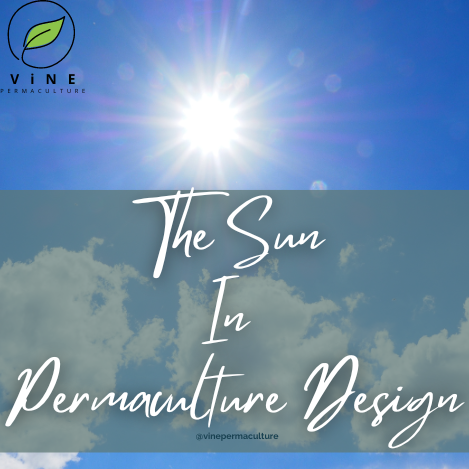How does a Permaculture design employ the Sun?
By observing the Sun’s motion seasonally to better capture (and avoid) its energy.
Permaculture is a design system that seeks to create sustainable and regenerative ecosystems that mimic nature. The sun is a key element in permaculture design as it is the primary source of energy for life on Earth. Understanding the sun and its patterns is essential for designing and managing permaculture systems. In this article, we will explore the importance of the sun in permaculture and five key points to consider when designing permaculture systems that harness the power of the sun.
1) Solar orientation
Permaculture design employs the sun’s orientation as a fundamental element in creating efficient and sustainable systems. By understanding the path of the sun throughout the year, permaculture practitioners strategically position elements to maximize exposure to sunlight. This practice has numerous benefits for both plants and buildings within the system.
In terms of plant cultivation, solar orientation plays a crucial role in optimizing photosynthesis and plant growth. By placing gardens, orchards, and crop fields in areas that receive the most sunlight, permaculture designs ensure that plants receive the energy they need to thrive. This can result in higher yields, improved crop quality, and better overall ecosystem health.
Additionally, solar orientation is vital in designing energy-efficient buildings within permaculture systems. By positioning structures in a way that captures and utilizes solar heat, designers can reduce the need for artificial heating and lighting. South-facing windows and solar panels on roofs are examples of how permaculture designs maximize solar exposure to provide natural lighting and passive solar heating.
By integrating solar orientation into permaculture design, practitioners harness the sun’s energy to create sustainable and regenerative systems. This approach reduces reliance on non-renewable energy sources, lowers environmental impact, and promotes self-sufficiency within the permaculture ecosystem.
2) Solar Water Heating
Permaculture employs various techniques to harness the sun’s energy for heating water in a sustainable and efficient manner. One commonly used method is through solar water heating systems. These systems can be either passive or active, depending on the design and technology utilized.
Passive solar water heating systems work by utilizing the sun’s rays to naturally heat water without the need for mechanical pumps or fans. They typically consist of a solar collector, which is a dark-colored, insulated panel or tube that absorbs the sun’s heat. Water is circulated through the collector by the principle of convection, where warm water rises and cooler water sinks. As the water circulates through the collector, it absorbs heat and is then stored in an insulated tank for later use. This stored hot water can be used for domestic purposes like bathing, washing, or space heating.
Active solar water heating systems, on the other hand, employ mechanical devices such as pumps and controls to circulate water through the solar collectors. These systems are more complex but can offer greater control and efficiency. Active systems use sensors and controllers to monitor the temperature of the water and regulate the flow between the collectors and storage tanks. This ensures optimal heat transfer and prevents overheating or freezing.
By harnessing this abundant and renewable resource, permaculture designs promote sustainability and contribute to the efficient use of natural resources.
3) Solar Electric Systems
Solar PV systems convert sunlight directly into electricity, providing a sustainable and renewable source of power for various functions within a permaculture system.
By integrating solar PV systems into their designs, permaculture practitioners prioritize energy independence and reduce reliance on non-renewable energy sources. These systems can power lighting, appliances, tools, and other electrical devices needed for daily operations. By generating clean energy from the sun, permaculture systems can minimize their environmental impact and contribute to a more sustainable future.
Moreover, permaculture design emphasizes energy efficiency in conjunction with solar PV systems. This includes optimizing building designs for passive solar heating and cooling, utilizing energy-saving appliances and lighting, and implementing effective insulation and thermal mass strategies. By combining these energy-efficient practices with solar PV systems, permaculture designs maximize the utilization of solar-generated power, reducing overall energy consumption and costs.
Solar PV electric systems in permaculture design also offer the opportunity for decentralized energy production. By installing solar panels on rooftops, pergolas, or other suitable structures, permaculture systems can generate electricity at the point of consumption, reducing transmission losses and promoting self-sufficiency.
In conclusion, incorporating solar PV electric systems into permaculture designs allows for the efficient utilization of the sun’s energy, fostering sustainable and resilient systems that prioritize renewable resources, energy efficiency, and decentralized power production.
4) Drying and Dehydration
In permaculture design, the sun plays a crucial role in the process of drying and dehydration. By harnessing the sun’s heat and energy, permaculture systems can effectively preserve and store a wide range of materials, such as food, herbs, and biomass. Solar drying and dehydration techniques offer a sustainable and low-energy approach to prolonging the shelf life of produce and reducing waste.
Permaculture designs incorporate various strategies to utilize the sun’s power for drying. Dedicated drying racks, solar dehydrators, or simply utilizing sun-drenched spaces are common elements found in permaculture systems. These structures and spaces allow materials to be spread out and exposed to the sun’s rays, promoting natural evaporation and moisture removal.
Solar drying and dehydration not only conserve energy but also enhance self-sufficiency. By relying on the sun’s energy instead of electricity or fossil fuels, permaculture practitioners reduce their ecological footprint. Additionally, solar drying preserves the nutritional value of food and herbs, ensuring that they can be enjoyed even when they are out of season.
By integrating solar drying and dehydration techniques into their designs, permaculture systems contribute to sustainable food production, reduce food waste, and promote resilience. The sun’s energy becomes a valuable resource for preserving the abundance of nature and fostering self-reliance within permaculture communities.
5) Heating & Cooling
Permaculture design incorporates the power of the sun to provide heating and cooling solutions, contributing to energy efficiency and reducing reliance on non-renewable resources. When it comes to heating, permaculture systems strategically harness the sun’s warmth through passive solar design principles. By orienting buildings and greenhouses to maximize exposure to sunlight, they capture and store solar heat during the day, effectively warming the structures. Additionally, materials with high thermal mass, such as adobe or rammed earth, can absorb and retain heat, releasing it gradually during cooler periods.
For cooling, permaculture design utilizes a combination of shading techniques and natural ventilation. By incorporating shade structures, such as trellises or deciduous trees, permaculture systems create cool and shaded areas that offer respite from the sun’s intensity. Natural ventilation techniques, such as positioning windows or vents strategically to encourage airflow, enhance the cooling effect. Passive cooling methods like earth-sheltered buildings or green roofs also aid in maintaining cooler temperatures by utilizing the insulating properties of the earth or the cooling effect of plants.
By employing these heating and cooling strategies, permaculture design optimizes the use of solar energy, reducing the need for conventional heating and cooling systems. This approach not only saves energy but also promotes a more sustainable and comfortable living environment.



